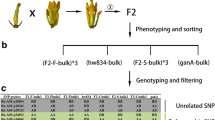Abstract
The combination of cytoplasmic male sterility (CMS) in one parent and a restorer gene (Rf) to restore fertility in another are indispensable for the development of hybrid varieties. We have found a rice Rf-1 gene that restores BT-type CMS by applying a positional cloning strategy. Using linkage analysis in combination with 6,104 BC1F3 progeny derived from a cross between two near-isogenic lines (NILs) differing only at the Rf-1 locus, we delimited the Rf-1 gene to a 22.4-kb region in the rice genome. Duplicate open reading frames (Rf-1A and Rf-1B) with a pentatricopeptide (PPR) motif were found in this region. Since several insertions and/or deletions were found in the regions corresponding to both the Rf-1A and Rf-1B genes in the maintainer’s allele, they may have lost their function. Rf-1A protein had a mitochondria-targeting signal, whereas Rf-1B did not. The Rf-1B gene encoded a shorter polypeptide that was determined by a premature stop codon. Based on the function of the Rf-1 gene, its product is expected to target mitochondria and may process the transcript from an atp6/orf79 region in the mitochondrial genome. Since the Rf-1A gene encodes a 791-amino acid protein with a signal targeting mitochondria and has 16 repeats of the PPR motif, we concluded that Rf-1A is the Rf-1 gene. Nine duplications of Rf-1A homologs were found around the Rf-1 locus in the Nipponbare genome. However, while some of them encoded proteins with the PPR motif, they do not restore BT-type CMS based on the lack of co-segregation with the restoration phenotype. These duplicates may have played diversified roles in RNA processing and/or recombination in mitochondria during the co-evolution of these genes and the mitochondrial genome.






Similar content being viewed by others
References
Akagi H, Sakamoto M, Shinjyo C, Shimada H, Fujimura T (1994) A unique sequence located downstream from the rice mitochondrial atp6 may cause male sterility. Curr Genet 25:52–58
Akagi H, Yokozeki Y, Inagaki A, Nakamura A, Fujimura T (1996) A codominant DNA marker closely linked to the rice nuclear restorer gene, Rf-1, identified with inter-SSR fingerprinting. Genome 39:1205–1209
Akagi H, Yokozeki Y, Inagaki A, Fujimura T (1997) Highly polymorphic microsatellites of rice consist of AT repeats, and classification of closely related cultivars with these microsatellite loci. Theor Appl Genet 94:61–67
Aubourg S, Boudet N, Kreis M, Lecharny A (2000) In Arabidopsis thaliana, 1% of the genome codes for a novel protein family unique to plants. Plant Mol Biol 42:603–613
Bentolila S, Alfonso AA, Hanson MR (2002) A pentatricopeptide repeat-containing gene restores fertility to cytoplasmic male-sterile plants. Proc Natl Acad Sci USA 99:10887–10892
Brown GG, Formanová N, Jin H, Wargachuk R, Dendy C, Patil P, Laforest M, Zhang J, Cheung WY, Landry BS (2003) The radish Rfo restorer gene of Ogura cytoplasmic male sterility encodes a protein with multiple pentatricopeptide repeats. Plant J 35:262–272
Edwards K, Johnstone C, Thompson C (1991) A simple and rapid method for the preparation of plant genome DNA for PCR analysis. Nucleic Acids Res 19:1349
Emanuelsson O, Nielsen H, Brunak S, von Heijne G (2000) Predicting subcellular localization of proteins based on their N-terminal amino acid sequence. J Mol Biol 300:1005–1016
Fujimura T, Akagi H, Oka M, Nakamura A, Sawada R (1996) Establishment of a rice protoplast culture and application of an asymmetric protoplast fusion technique to hybrid rice breeding. Plant Tissue Cult Lett 13:243–247
Hossain M (1996) Economic prosperity in Asia: implications for rice research. In: Khush GS (ed) Rice genetics III. IRRI, Manila, Philippines, pp 3–16
Ichikawa N, Kishimoto N, Inagaki A, Nakamura A, Koshino Y, Yokozeki Y, Oka M, Samoto S, Akagi H, Higo K, Shinjyo C, Fujimura T, Shimada H (1997) A rapid PCR-aided selection of a rice line containing the Rf-1 gene, which is involved in restoration of the cytoplasmic male sterility. Mol Breed 3:195–202
Iwabuchi M, Kyozuka J, Shimamoto K (1993) Processing followed by complete editing of an altered mitochondrial atp6 RNA restores fertility of cytoplasmic male sterile rice. EMBO J 12:1437–1446
Jing R, Li X, Yi P, Zhu Y (2001) Mapping fertility-restoring genes of rice WA cytoplasmic male sterility using SSLP markers. Bot Bull Acad Sin 42:167–171
Katsuo K, Mizushima U (1958) Studies on the cytoplasmic difference among rice varieties, Oryza sativa L. Jpn J Breed 8:1–5
Kazama T, Toriyama K (2003) A pentatricopeptide repeat-containing gene that promotes the processing of aberrant atp6 RNA of cytoplasmic male-sterile rice. FEBS Lett 544:99–102
Koizuka N, Imai R, Fujimoto H, Hayakawa T, Kimura Y, Kohno-Murase J, Sakai T, Kawasaki S, Imamura J (2003) Genetic characterization of a pentatricopeptide repeat protein gene, orf687, that restores fertility in the cytoplasmic male-sterile Kosena radish. Plant J 34:407–415
Kosambi DD (1944) The estimation of map distances from recombination values. Ann Eugen 12:172–175
Kurata N, Nagamura Y, Yamamoto K, Harushima Y, Sue N, Wu J, Antonio BA, Shomura A, Shimizu T, Lin S-Y, Inoue T, Fukuda A, Shimano T, Kuboki Y, Toyama T, Miyamoto Y, Krihara T, Hayasaka K, Miyao A, Monna L, Zhong HS, Tamura Y, Wang Z-X, Momma T, Umehara Y, Yano M, Sasaki T, Minobe Y (1994) A 300-kilobase interval genetic map of rice including 883 expressed sequences. Nat Genet 8:365–372
Lahmy S, Barnech F, Derancourt J, Filipowicz W, Delseny M, Echeverria M (2000) A chloroplastic RNA-binding protein is a new member of the PPR family. FEBS Lett 480:255–260
Levings CSIII, Brown GG (1989) Molecular biology of plant mitochondria. Cell 56:171–179
Levings CS III, Vasil IK (1995) The molecular biology of plant mitochondria. Kluwer, Dordrecht
Li X-Q, Jean M, Landry BS, Brown GG (1998) Restorer genes for different forms of Brassica cytoplasmic male sterility map to a single nuclear locus that modifies transcripts of several mitochondrial genes. Proc Natl Acad Sci USA 95:10032–1 0037
Li Z, Zho Y (1986) Rice male-sterile cytoplasm and fertility-restoration. In: IRRI (ed) Hybrid rice. IRRI, Manila, Philippines, pp 85–102
Lichtenstein CP, Draper J (1985) Genetic engineering of plants. In: Glover DM (ed) DNA cloning, vol 3. Practical approach. IRL Press, Oxford, pp 67–119
Nakagawa Y, Machida C, Machida Y, Toriyama K (2000) Frequency and pattern of transposition of the maize transposable element Ds in transgenic rice plants. Plant Cell Physiol 41:733–742
Newton KJ (1988) Plant mitochondrial genomes: Organization, expression and variation. Annu Rev Plant Physiol Plant Mol Biol 39:503–532
Pruitt KD, Hanson MR (1991) Transcription of the Petunia mitochondrial CMS-associated Pcf locus in male sterile and fertility-restored lines. Mol Gen Genet 227:348–355
Schuable PS, Wise RP (1998) The molecular basis of cytoplasmic male sterility and fertility restoration. Trends Plant Sci 3:175–180
Shinjyo C (1969) Cytoplasmic genetic male sterility in cultivated rice, Oryza sativa L. II. The inheritance of male sterility. Jpn J Genet 44:149–156
Shinjyo C (1975) Genetical studies of cytoplasmic male sterility and fertility restoration in rice, Oryza sativa L. Sci Bull Coll Agric Univ Ryukyus 22:1–51
Shinjyo C (1984) Cytoplasmic male sterility and fertile restoration in rice having genome A. Biology of rice. Japan Science Societies, Elsevier Press, Tokyo
Singh M, Hamel N, Menassa R, Li X-Q, Young B, Jean M, Landry BS, Brown GG (1996) Nuclear genes associated with a single Brassica CMS restorer locus influence transcripts of three different mitochondrial gene regions. Genetics 143:505-516
Small ID, Peeters N (2000) The PPR motif—a TPR-related motif prevalent in plant organellar proteins. Trends Biochem Sci 25:46–47
Tan KL, Vanavichit A, Amornsilpa S, Trangoonrung S (1998) Genetic analysis of rice CMS-WA fertility restoration based on QTL mapping. Theor Appl Genet 96:994–999
Tang HV, Pring DR, Shaw LC, Salazar RA, Muza FR, Yan B, Schertz KF (1996) Transcript processing internal to a mitochondrial open reading frame is correlated with fertility restoration in male-sterile sorghum. Plant J 10:123–133
Tang HV, Chang R, Pring DR (1998) Cosegregation of single genes associated with fertility restoration and transcript processing of sorghum mitochondrial orf107 and urf209. Genetics 150:383–391
Teng L-S, Shen Z-T (1994) Inheritance of fertility restoration for cytoplasmic male sterility in rice. Rice Genet Newsl 11:95–97
Virmani SS, Shinjyo C (1988) Current status of analysis and symbols for male-sterile cytoplasms and fertility-restoring genes. Rice Genet Newsl 5:9–15
Wise RP, Gobelman-Werner K, Pei D, Dill CL, Schnable PS (1999) Mitochondrial transcript processing and restoration of male fertility in T-cytoplasm maize. J Hered 90:380–385
Yao FY, Xu CG, Yu SB, Li JX, Gac YJ, Li XH, Zhang Q (1997) Mapping and genetic analysis of two fertility restorer loci in the wild-abortive cytoplasmic male sterility system of rice (Oryza sativa L.). Euphytica 98:183–187
Yuan LP (1994) Increasing yield potential in rice by exploitation of heterosis. In: Virmanni SS (ed) Hybrid rice technology. New developments and future prospects. IRRI, Manila, Philippines, pp 1–6
Zhang Q, Bharaj TS, Virmani SS, Huang H (1997) Mapping of the Rf-3 nuclear fertility restoring gene for WA cytoplasmic male sterility in rice using RAPD and RFLP markers. Theor Appl Genet 94:27–33
Acknowledgements
The authors thank Dr. Shinjyo for kindly providing the seeds of the near-isogenic lines of rice. This research was supported in part by a Grant-in-Aid for Scientific Research C (No. 12660008) from the Ministry of Education, Science and Culture, Japan.
Author information
Authors and Affiliations
Corresponding author
Additional information
Communicated by M. Mackill
Sequence data from this article have been deposited with the EMBL/Genebank Data Libraries under accession nos. AB112808, AB112809, AB112810, AB112811.
Rights and permissions
About this article
Cite this article
Akagi, H., Nakamura, A., Yokozeki-Misono, Y. et al. Positional cloning of the rice Rf-1 gene, a restorer of BT-type cytoplasmic male sterility that encodes a mitochondria-targeting PPR protein. Theor Appl Genet 108, 1449–1457 (2004). https://doi.org/10.1007/s00122-004-1591-2
Received:
Accepted:
Published:
Issue Date:
DOI: https://doi.org/10.1007/s00122-004-1591-2




